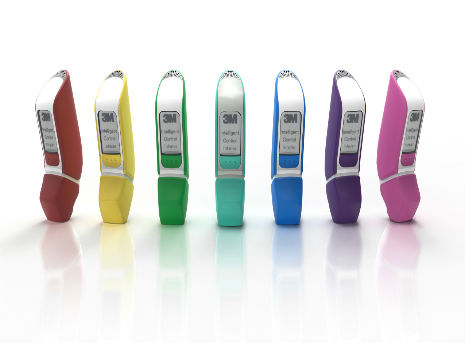3M unveils intelligent inhaler designed to help control spiraling costs of respiratory disease

3M Drug Delivery Systems Unveils 3M(tm) Intelligent Control Inhaler (Photo: 3M)
Technology aims to solve patient competence and adherence challenges, minimizing burden on health care providers and payers.
Research shows that an estimated 334 million people have asthma worldwide, and 65 million people have moderate to severe COPD — a number that is expected to rise 24% by the year 2034 to make COPD the world’s third leading cause of death. As cases increase, driven by the ageing population, hospitals and care providers continue to see low levels of adherence and poor and inconsistent competence using current treatment devices. This has led to sub-optimal outcomes and higher rates of hospital admissions. Answering the need for a solution to device misuse and adherence issues, 3M Drug Delivery Systems introduces the 3M Intelligent Control Inhaler, an intuitive, fully-integrated device that delivers accurate doses to patients, whilst providing on-screen instructions for use and feedback to the patient and healthcare provider via an app.
“Providing an effective and intuitive delivery method for respiratory disease treatment is critical to patients, health care providers and payers alike,” said Louise Righton, Global Marketing Operations Manager, 3M Drug Delivery Systems. “Poor technique in using an inhaler, coupled with the challenges of getting patients to adhere to their medication protocols, can lead to exacerbations, increased use of health care resources and ultimately, a burden on health care systems. By increasing competence and adherence, we can realize better patient outcomes and reduce health care costs.”
The 3M Intelligent Control Inhaler provides a number of unique features that offer opportunities to improve outcomes by reducing patient variability and errors, and providing data on use to health care providers and payers:
“We’ve done a tremendous amount of research during the development of this technology with patients, health care providers, and payers,” said Dr Steven Wick, Technical Director, 3M Drug Delivery Systems. “With 60 years of experience in inhalation technologies, and 30 years in health information systems, 3M is uniquely qualified to bring forth a solution that is a definitive win for each of these stakeholders. Nothing has worked to improve inhaler technique over the past 25 years — and here we have a connected device to improve both competence AND adherence. The need for a smarter solution has never been greater, and 3M intends to put greater control of respiratory disease into the hands of patients, health care providers and payers.”
Related News
-
News Patients vs Pharma – who will the Inflation Reduction Act affect the most?
The Inflation Reduction Act brought in by the Biden administration in 2022 aims to give better and more equitable access to healthcare in the USA. However, pharma companies are now concerned about the other potential costs of such legislation. -
News CPHI Podcast Series: What does the changing US Pharma market mean for industry and patients alike?
In this week's episode of the CPHI Podcast Series Lucy Chard, Digital Editor for CPHI Online is joined by James Manser to discuss the political and market changes in the US pharma field. -
News CPHI Barcelona Annual Report illuminates industry trends for 2024
The CPHI Annual Survey comes into it’s 7th year to report on the predicted trends for 2024. Over 250 pharma executives were asked 35 questions, with their answers informing the industry landscape for the next year, spanning all major pharma marke... -
News Which 10 drugs are open to price negotiation with Medicare in the USA?
The Centres for Medicare & Medicaid Services, under the Biden administration in the USA, has released a list of the 10 drugs that will be open to price negotiations as part of the new legislation under the Inflation Reduction Act (IRA). -
News EU Medical Devices Regulation causes unintended disappearances of medical devices for children, doctors state
Doctor groups and associations have appealed to the EU to correct the EU Medical Devices Regulation law that may cause unintended shortages of essential drug and medical devices for children and rare disease patients. -
News 10 Major Drug Approvals So Far in 2023
Last year, 37 novel drugs were approved by the FDA, this was a high number for such a category, and covered many fields including oncology, demonstrating how promising further research is, and how it is only continuing to build. To date, there are alre... -
News Detecting Alzheimer's disease with a simple lateral flow test
A novel rapid diagnostic test for early-stage Alzheimer's disease has been developed using a biomarker binder from Aptamer Group along with technology from Neuro-Bio, the neurodegenerative disease experts. -
News CPHI Podcast Series: outsourcing and manufacturing trends
Listen to the CPHI Podcast Series this June to hear Gil Roth of the PBOA speak with Digital Editor Lucy Chard about the biggest trends and topics to watch in pharma outsourcing and manufacturing at the minute.
Position your company at the heart of the global Pharma industry with a CPHI Online membership
-
Your products and solutions visible to thousands of visitors within the largest Pharma marketplace
-
Generate high-quality, engaged leads for your business, all year round
-
Promote your business as the industry’s thought-leader by hosting your reports, brochures and videos within your profile
-
Your company’s profile boosted at all participating CPHI events
-
An easy-to-use platform with a detailed dashboard showing your leads and performance







